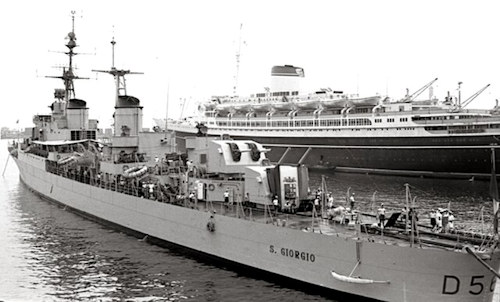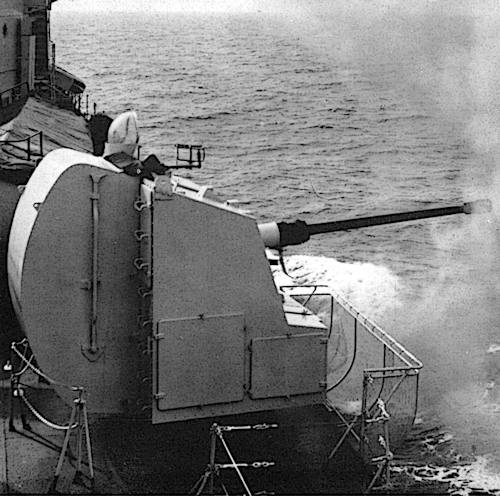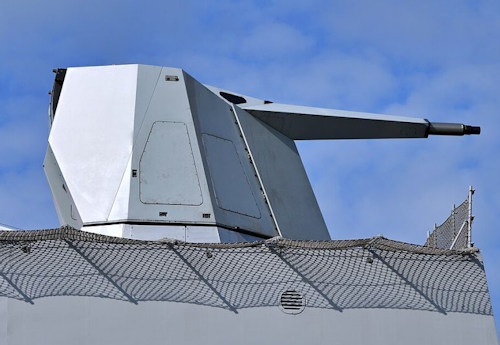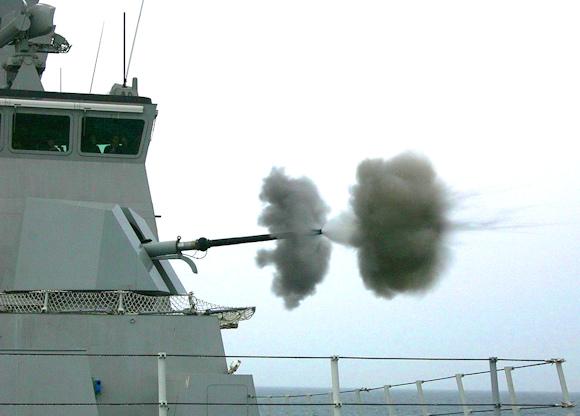After World War II, upon joining NATO, Italy received much of its armaments from the United States in the form of a “direct military assistance program” (MDAP). This included two destroyers of the type Benson / Livermoore which were renamed Aviere ed Gunner (dating back to the 40s), three frigates that made up the class Aldebaran (Aldebaran, Altair, Andromeda) and other units that were profitably used for team activity and provided a valid contribution to the design of subsequent national construction units.
At the same time, in 1950, the recovery and transformation of two light cruisers of the class took place Roman Captains, the 'Pompeo Magno' and the 'Giulio Germanico' which had been self-scuttled by the Germans.
The two old units, transformed into destroyers, were renamed respectively St. George (following photo) e Saint Mark entering service between 1955 and 1956. The weapon systems of these units were updated to meet new operational needs to counter increasingly fast and lethal air and missile threats.

Originally, as regards artillery, Italian naval ships were mostly equipped with US-made naval armaments, including the 5-inch USN gun (127/38) and the Bofors 40mm/L60.
These were weapons which, according to the general staff of the Italian Navy at the time, were not adequate for real needs because: the 127 mm was considered too heavy to be used by overall smaller units, while on the contrary the 40 mm/L60 it was too light to be used on the corvettes included in the modernization plan.
Thus, within the Navy General Staff, an operational requirement was born for the development of a medium-caliber cannon for use against surface and air targets, based on US Navy studies of a 3-inch (76,2 mm) weapon. , considered a good compromise between the two calibers mentioned. The task was therefore given to the Italian company OTO Melara of La Spezia to create, with the collaboration of the Italian Navy, a new armament that would be primary on smaller warships (corvettes) or secondary on larger warships such as frigates and destroyers.

The first prototype built was a twin-linked cannon, the 76mm/L62 SMP3 (“Stabilimenti Meccanici di Pozzuoli – 3-inch gun”) Superimposed (so called because the two barrels were positioned one above the other rather than side by side) as with most naval gun turrets. The experimentation carried out on the class Centaur it was unsatisfactory and, in 1958, OTO Melara began work on a single-barreled version of which the first example was delivered in 1961 for sea trials.
The first in 1962 76/62 MMI Enlarged it was delivered to the Italian Navy to be mounted on class frigates Carlo Bergamini. In the following five years, OTO-Melara produced a total of 84 which were embarked on all the Italian warships that previously had the 76mm/L62 SMP3 Over and Under. 76/62 MMI it is still in service on class patrol boats Cassiopeia.
The 76/62 MMI
Hoping not to make too many inaccuracies, I will briefly describe this weapon that those who served in the Italian Navy from the end of the 70s will remember with a certain nostalgia. The cannon was housed in a watertight turret that also protected against small shell splinters and housed an operator possibly needed to locally direct the cannon based on data provided by the ship's fire control system. The rotation of the cannon was carried out via a hydraulic-electric system, with backup manual.
Ammunition was stored in a magazine under the turret, from which rounds were carried to the elevators and then into the breech for firing. Spent cartridge cases were ejected out of the turret (and were collected by a net to reuse the material). The total weight of the turret and magazine was 12 tons and the gun had a rate of fire of between 10 and 60 rounds per minute.
 In the late 60s, the 76/62 MMI was replaced by theOTO-Melara 76mm Compact (76/62 C), capable of firing 85 rounds per minute; a cannon which had great success at an international level due to its compactness and performance, also thanks to its lighter weight compared to the previous one.
In the late 60s, the 76/62 MMI was replaced by theOTO-Melara 76mm Compact (76/62 C), capable of firing 85 rounds per minute; a cannon which had great success at an international level due to its compactness and performance, also thanks to its lighter weight compared to the previous one.
The compact in turn evolved towards the 76/62SR and 76/62 Strales and was purchased by over 60 international navies.
The 76/62 SR
Currently in service on many combatant ships, the Super Quick it can fire 120 rounds per minute using different types of ammunition. It was introduced in the 80s and installed on Navy units up to the class Horizon, also as a point defense system.
Soon the Italian navy preferred the Super Quick improved with Strales system and DART ammunition in the anti-missile defense role as it is capable of countering both various subsonic missiles (up to 8.000 meters away) and air and surface targets.
It is installed on the Multi-Mission European Frigates (FREMM): two per unit in version Anti-submarine and one in the version General Purpose.
His version dictated Overbridge (“over deck”), more compact and about 30–40% lighter than Super Quick standard, does not require penetration of the underlying deck for installation, being able to accommodate 76 rounds ready to fire inside (both with or without system Strales).
The Overbridge (following photo) was installed for the first time on Multi-purpose Offshore Patrol (PPA) class Thaon of Revel of the Italian Navy, above the roof of the helicopter hangar.

The ammunition that makes the difference
Among the types of ammunition I want to mention:
HE standards: weight 6.296 kg, standard ammunition with maximum range 16 km, effective range 8 km (10 km against aerial targets at 85°)
PFF: anti-missile projectile, with proximity fuze and tungsten spheres incorporated into the shell for a well-defined fragmentation effect
SAPOM: 6,35 kg (0,46 kg HE), range 16 km (SAPOMER: 20 km) armor-piercing projectile with semi-armor against naval and land targets on the coast
DART: Guided projectile against air and missile targets
Mini-VOLCANO: guided projectile with a maximum range of around 40 km (a smaller version of the same ammunition used by the VULCANO system of the new 127 mm cannons carried on the FREMM General Purpose and PPAs)
In particular, as regards the last two (guided ammunition), they were designed in the 80s; the first munition of this type was the CCS (Course Corrected Shell), also called 'CORRECT', the result of a joint OTO and British Aerospace program that began in 1985 to create a projectile equipped with small rockets to divert its trajectory through radio commands sent from the ship. The system proved to be too complex and unreliable and OTO Melara studied a new system called DAVIDE (only for the Italian market) and, later, the STRALES version for export.
The guided munition was called DART (Driven Ammunition Reduced Time of flight): in simple words, its projectile is guided with radio controls to the target and has a proximity fuze for low-level engagement (up to 2 meters above the sea surface, which also makes it interesting against naval targets of limited dimensions) and with a speed of 1.200 m/s (it can reach a range of 5 km in just 5 seconds with maneuvers of up to 40 G).
The DART projectile is made up of two parts: the front one is free to rotate and has two small “canard” wings for flight control, while the aft one houses the 2,5 kg warhead, six fixed wings and radio receivers. This type of ammunition has been tested since 2014, reaching considerable maturity and reliability.
(We thank the managing director Fernando Cerutti and the managing director Giuseppe Manca for their advice)
Photo: web
(article originally published on https://www.ocean4future.org)












